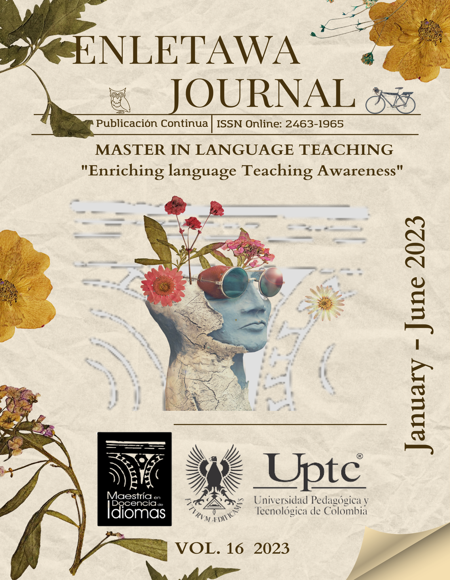An English Language and Methodology Course for Training Content Area Teachers

Abstract
This research was conducted with ten elementary school content teachers from a private educational institution in the department of Quindío in order to determine the influence of a language and methodology course on the development of teachers' professionalism and English language proficiency. To determine the impact of the course, qualitative research was carried out in which six three-hour workshops were applied and three different perspectives were gathered after each session in the form of questionnaires, a teacher's journal, and a peer observer format. According to the results, the implementation of the CBI in the course was successful because it had an impact on teachers’ perceptions, content teachers’ language proficiency and their professional development; the majority of teachers demonstrated an improvement in their English language skills.
Keywords
Content teachers, CBI, language and course methodology, Professional development, teachers’ perceptions
Author Biography
Francisco Javier Sabogal Patiño
He has got his BA in Modern Languages at the Universidad del Quindío, and MA in English Didactics at Universidad de Caldas. He is interested in research about language teaching, and teachers’ professional development.
References
- Banegas, D. L. (2012). Integrating content and language in English language teaching in secondary education: Models, benefits, and challenges. Studies in Second Language Learning and Teaching, 2 (1), 111-136. https://doi.org/10.14746/ssllt.2012.2.1.6 DOI: https://doi.org/10.14746/ssllt.2012.2.1.6
- Barrios, E., and Milla, M. D. (2018). CLIL methodology, materials and resources, and assessment in a monolingual context: an analysis of stakeholders’ perceptions in Andalusia. The Language Learning Journal, 48 (1), 60-80. https://www-tandfonline-com.ezproxy.ucaldas.edu.co/doi/full/10.1080/09571736.2018.1544269 DOI: https://doi.org/10.1080/09571736.2018.1544269
- Borko, H. (November 1st 2004). Professional Development and Teacher Learning: Mapping the Terrain. Educational Research, 33 (8), 3-15. Sage Journals. https://doi.org/10.3102/0013189X033008003 DOI: https://doi.org/10.3102/0013189X033008003
- Brinton, D., Snow, M. and Wesche, M. (1989). Content-Based Second Language Instruction. Boston: Heinle and Heinle Publishers.
- Brinton, D., and Snow, A. (2017). The Evolving Architecture of Content-Based Instruction. In The content-based classroom. University of Michigan Press. https://www.press.umich.edu/8198148/content_based_classroom_second_edition/?s=look_inside
- Bryk, A. (April 1st, 2010). Organizing Schools for Improvement. Sage Journals, 91 (7), 22-30. https://doi.org/10.1177%2F003172171009100705 DOI: https://doi.org/10.1177/003172171009100705
- Bula, O. (January 15th, 2013). Content-Based Instruction: A Relevant Approach of Language Teaching. Innovaciones Educativas, 15 (20), 71-83. https://dialnet.unirioja.es/servlet/articulo?codigo=5181354 DOI: https://doi.org/10.22458/ie.v15i20.515
- Butler, Y. (2005). Content-based instruction in EFL contexts: Consideratios for effective implementation. JALT Journal, 27 (2), 227-245. https://jalt-publications.org/jj/articles/2606-perspectives-content-based-instruction-efl-contexts-considerations-effective-implem. DOI: https://doi.org/10.37546/JALTJJ27.2-5
- Cenoz, J. (2015). Content-based instruction and content and language integrated learning: the same or different? Language, Culture and Curriculum, 28 (1), 8-24. https://biblio.ucaldas.edu.co/bases-de-datos/. https://doi.org/10.1080/07908318.2014.1000922. DOI: https://doi.org/10.1080/07908318.2014.1000922
- Coyle, D. (1999). Theory and planning for effective classrooms: Supporting students in content and language integrated learning contexts. In Masih, J (Ed), Learning through a Foreign Language: Models, Methods and Outcomes. 46-62. https://eric.ed.gov/?id=ED454735
- Creswell, J. W. and Creswell J.D. (2009). Research Design: Qualitative, quantitative, and mixed methods approaches (3rd ed.). Sage Publications, Inc.
- Craft, A. (2000). Continuing professional development. Routledge and Falmer.
- Fullan, M. (2007). The new meaning of educational change. Teachers College Press.
- Freeman, D. (2004). Implications of sociocultural perspectives for language teacher Education. In M.Hawkins, Language Learning and Teacher (pp. 169-197). Multilingual Matters Ltd. http://www.jstor.org/stable/40264058 DOI: https://doi.org/10.21832/9781853597657-010
- Freeman, D. (1989). Teacher training, development, and decision making: A model of teaching and related strategies for language teacher education. TESOL Quarterly, 23(1), 27. https://doi.org/10.2307/3587506 DOI: https://doi.org/10.2307/3587506
- Garzón, E. (March 28th, 2018). From cultural awareness to scientific citizenship: implementing content and language integrated learning projects to connect environmental science and English in a state school in Colombia. International Journal of Bilingual Education and
- Bilingualism, 24 (2), 242-259. https://doi.org/10.1080/13670050.2018.1456512 DOI: https://doi.org/10.1080/13670050.2018.1456512
- Johnston, B. (2009). Collaborative teacher development. In A. Burns & J. C. Richards (Eds.), The Cambridge guide to language teacher education (pp. 241-229). Cambridge University Press. DOI: https://doi.org/10.1017/9781139042710.032
- Krahnke, K. (1987). Approaches to Syllabus Design for Foreign Language Teaching. Language in Education: Theory and Practice. ERIC Institute of Education of Science, (67). https://eric.ed.gov/?id=ED283385
- Kemmis, S. and McTaggart, R. (2005). Participatory Action Research: Communicative Action and the Public Sphere. Sage Publications.
- Lazarević, N. (December 18th, 2019). CLIL teachers’ reflections and attitudes: surviving at the deep end. International Journal of Bilingual Education and Bilingualism, 25 (2), 571-584. Universidad de Caldas. https://doi-org.ezproxy.ucaldas.edu.co/10.1080/13670050.2019.1703897 DOI: https://doi.org/10.1080/13670050.2019.1703897
- Little, J. (2011). Professional Community and Professional Development in the Learning-Centered School. In Kooy, M. and van Veen, K., Teacher Learning That Matters (pp. 22-46). Routledge. https://doi.org/10.4324/9780203805879 DOI: https://doi.org/10.4324/9780203805879
- Marsh, D. (1994), Bilingual Education and Content and Language Integrated Learning: Language Teaching in the Member States of the European Union (Lingua). University of Sorbonne: International Association for Cross-cultural Communication.
- Mackey, A. & Gass, S.M. (2012). Research Methods in Second Language Acquisition: A Practical Guide. 10.1002/9781444347340. DOI: https://doi.org/10.1002/9781444347340
- Pérez, M. (2019). Meeting CLIL teachers’ training and professional development needs. NABE Journal of Research and Practice, 9 (3-4), 119-127. https://doi-org.ezproxy.ucaldas.edu.co/10.1080/26390043.2019.1634961 DOI: https://doi.org/10.1080/26390043.2019.1634961
- Richards, J. and Rodgers, T. (2001). Approaches and Methods in Language Teaching. Second Edition. New York: Cambridge University Press. DOI: https://doi.org/10.1017/CBO9780511667305
- Richter D., Kunter M., Klusmann U., Lüdtke O., Baumert J. (2014) Professional Development Across the Teaching Career. In S. Krolak- DOI: https://doi.org/10.1007/978-94-6209-536-6_7
- Schwerdt, S. Glock, M. Böhmer (Eds.), Teachers’ Professional Development. The Future of Education Research. (pp. 97-121). SensePublishers.
- Ruiz de Zarobe, Yolanda and Cenoz, Jasone. (2015). Way forward in the twenty-first century in content-based instruction: moving towards integration. Language, Culture and Curriculum. 28. 90-96. 10.1080/07908318.2014.1000927 DOI: https://doi.org/10.1080/07908318.2014.1000927
- Timperley, H. (2011). Realizing the power of professional learning. London: McGraw-Hill Education.